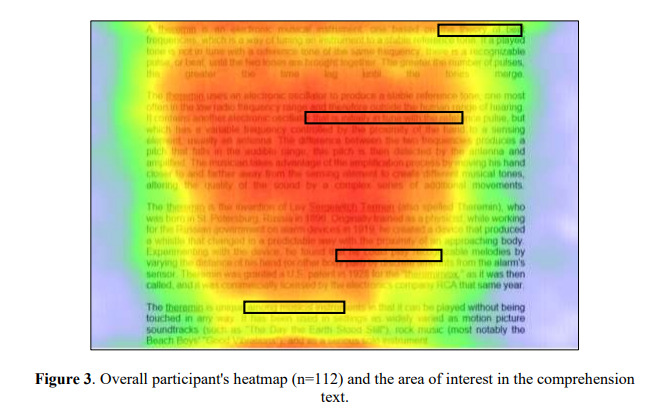
Reading performance is a crucial skill that can predict success in education. Many factors can influence reading performances, such as background music and perceiving the sentences while reading. This study explores the effects of music on screen-based reading materials among health sciences university students. One hundred twelve participants from The National University of Malaysia, Kuala Lumpur Campus, participated in this study. Participants were asked to read and understand the general theme text given on the computer screen. The participants were segregated into two groups according to their preferred way of reading, either music or non-music. Then, participants in the music group randomly listened to rap or classic music (rap = 86 BPM or classic = 161 BPM) using a Sony headphone (MDR-XB450AP) while reading. The reading duration was recorded, and reading comprehension was determined by the correct answers to four questions based on the text. A webcam-based GazeRecorder software was used to measure the eyetracking metrics (dwell time, first view time, and number of AOI views) on the area of interest (AOI). Reading speed is significantly associated with reading comprehension (rs = -0.1933, p = 0.0412). Reading duration, reading speed, and reading comprehension were not considerably different while listening to and not listening to music. The results show a similar pattern in all eye-tracking metrics. However, the reading duration while listening to rap music (2.68 ± 1.94 minutes) was significantly shorter (U = 299.5, p = 0.02642) compared to classical music (3.42 ± 1.91 minutes). Moreover, reading speed is significantly higher (U = 299.5, p = 0.02642) while listening to rap music (139.38 ± 102.96 wpm) as compared to classical music (109.47 ± 51.51 wpm). Music seems not to affect reading performance and eye-tracking metrics. Despite this, rap music can improve reading performance by reducing the reading duration and increasing reading speed.
https://publisher.unimas.my/ojs/index.php/JCSHD/article/view/5933
Introduction
In an age where online learning and digital reading materials have become integral to our education, understanding the factors that influence our reading experience is more important than ever. A recent eye-tracking study conducted at the Faculty of Health Sciences, Universiti Kebangsaan Malaysia, sheds light on the role of background music while reading screen-based materials among university students. What makes this study unique is the use of GazeRecorder, a cutting-edge webcam eye tracking software that allowed researchers to gain insights into participants’ eye movement patterns and behaviors as they read on a computer screen.
The Study
The research, led by Mohd Izuan Ibrahim, Rukiah A. Latif, and Afiq Mustafa Kamal, aimed to explore how background music affects reading performance. The study included 112 participants from The National University of Malaysia, Kuala Lumpur Campus, and it was conducted from 17 November 2020 to 19 December 2020.
Key Findings
One of the study’s primary objectives was to investigate whether background music influences reading duration, reading speed, and reading comprehension. It also sought to understand how eye-tracking metrics, including dwell time, first view time, and the number of area of interest (AOI) views, were affected by the presence of music.
Surprisingly, the results revealed that there was no significant difference in reading performance when background music was introduced. This suggests that various factors, such as individual preferences and the type of stimuli, can influence a student’s ability to focus while reading with music. It challenges the notion that music always acts as a distraction and can even improve reading and academic performance for some students.
The Role of GazeRecorder
The study’s unique aspect was the use of GazeRecorder software, a webcam-based eye tracking tool. This technology allowed the researchers to collect high-quality eye movement data, including dwell time, first view time, and the number of AOI views. These metrics provided valuable insights into how students interact with screen-based reading materials.
The heatmap generated by GazeRecorder highlighted the participants’ focus on the central reading material, helping to visualize their gaze patterns. Such visualizations are crucial for understanding how students read and engage with digital content.
Additionally, GazeRecorder enabled the research team to study eye-tracking metrics under different conditions, such as when students listened to background music or read in silence. This flexibility allowed for a comprehensive analysis of the impact of music on reading performance.
Future Implications
The findings of this study raise important questions about how we approach studying and reading. While it’s clear that there’s no one-size-fits-all answer when it comes to background music and reading, understanding individual preferences and adjusting study habits accordingly is crucial.
Furthermore, this research highlights the potential of eye tracking software like GazeRecorder in gaining a deeper understanding of reading behavior. Such software can help educators and researchers explore the nuances of how students interact with digital materials, leading to more effective and tailored teaching methods.
Conclusion
The study conducted at the Faculty of Health Sciences, Universiti Kebangsaan Malaysia, using GazeRecorder webcam eye tracking software, has provided valuable insights into the relationship between background music, reading performance, and eye-tracking metrics. The results challenge common assumptions about the impact of music on reading and emphasize the importance of individual preferences.
As we continue to navigate the digital age of learning, eye-tracking technology like GazeRecorder promises to be a valuable tool for researchers, educators, and students. It offers a deeper understanding of reading habits, paving the way for more effective and personalized study approaches.
So, the next time you open your digital textbooks or e-journals, consider your own reading habits and preferences. Music or no music, every student has their unique way of learning, and understanding these nuances is key to success in the digital learning era.